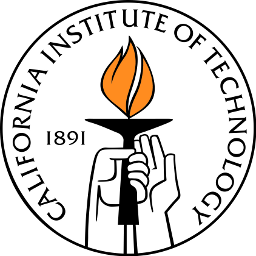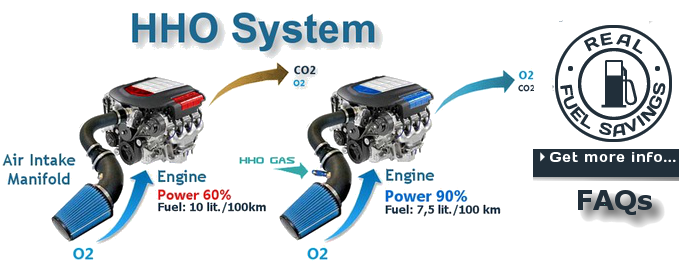Vores HHO-generatorer bruger elektrolyse til at opdele vand (H₂O) i brint (H₂) og oxygen (O₂), hvilket danner HHO-gas. Denne gas ledes derefter ind i forbrændingskammeret via luftindtaget, hvor den blandes med vores almindelige brændstof.
Vi bruger en lille mængde af bilens energi til at producere brint, men når den tilføjes forbrændingen, forbedrer den effektiviteten og frigiver mere energi, end der bruges til at producere brinten selv, hvilket betydeligt reducerer brændstofforbruget og forureningen!

NASA udførte flere undersøgelser om brugen af brint som et supplementært brændstof i en forbrandingsmotor, der kører på benzin. Deres forskning viste specifikt, at brintens høje flammespeed muliggjorde en udvidet effektiv lean-driftsrange i en benzinmotor. Lean-forblandingsforhold i forbrandingsmotorer har potentiale til at producere lave emissioner og højere termisk effektivitet af flere årsager:
1. Overskydende oxygen i ladningen oxiderer yderligere ubrandte kulbrinter og carbonmonoxid.
2. Overskydende oxygen sænker de højeste forbrændingstemperaturer, hvilket hæmmer dannelsen af nitrogenoxider.
3. Lavere forbrændingstemperaturer øger blandingens specifikke varmekapacitet ved at reducere nettodissociations tab.
4. Når den specifikke varmekapacitet stiger, forbedres cyklens termiske effektivitet også, hvilket potentielt fører til bedre brændstoføkonomi.

CALTECH, udførte også forskning om beregning af den termiske effektivitet af systemets brændstoføkonomi ved brug af supplementær brint. Den samlede motoreffektivitet stiger og opvejer energitabet ved produktion af brint, hvilket resulterer i forbedret brændstoføkonomi for systemet som helhed.
![]()
Motormoment
En gennemsnitlig stigning på 19,1% i motormoment opnås ved brug af HHO sammenlignet med ren diesel drift. Effektstigningen skyldes oxygenkoncentrationen i HHO-gas og den forbedrede blanding af HHO med luft og brændstof, hvilket forbedrer forbrændingen.

Resultaterne viser, at tilføjelsen af HHO kan betydeligt udvide det brændbare område og udvide grænsen for brændbarhed til lavere ækvivalensforhold. Da HHO-gas har en lav antændelsesenergi og en hurtig flammespeed, antændes HHO-dieselblandingen lettere og forbrændes hurtigere end ren dieselbrændstof. Dermed kan forbedret moment ved høje hastigheder opnås.
![]()
Motortemperatur
Den høje laminære flammespeed af HHO reducerer antændelsesforsinkelsen og forkorter forbrændingsperioden, hvilket fører til lavere varmetab og en forbrændingsproces tættere på ideelle konstant-volumen-forhold. Dette resulterer i en øget kompressionsratio og højere termisk effektivitet, hvilket i sidste ende sænker motortemperaturen.
![]()
Motorstøj
Den høje forbrændingshastighed af hydroxy resulterer i en hurtigere stigning i tryk og temperatur, hvilket kan minimere bankning, især ved tomgangsforhold (lav eller ingen belastning). Derudover fører reduktionen i antændelsesforsinkelsesperioden til reduceret motorstøj.
![]()
Brændstofforbrug
En gennemsnitlig besparelse på mere end 20% i SFC (Specific Fuel Consumption) opnås ved brug af HHO-systemet. Reduktionen i brændstofforbruget skyldes den ensartede blanding af HHO med luft (høj diffusivitet af HHO) og den højere tilstedeværelse af oxygen, som understøtter dieselforbrændingen og forbedrer effektiviteten. De højeste besparelser opnås ved høje hastigheder, fordi dieselbrændstof er svært at brænde fuldstændigt under lean-forhold på grund af den øgede restgasfraktion og dårlig blanding. Da HHO har en høj flammespeed og bred brændbarhedsrange, hjælper tilføjelsen af brint brændstoffet med at brænde hurtigere og mere fuldstændigt.

![]()
Carbonemissioner
En gennemsnitlig reduktion på 13,5% i CO-emissioner opnås ved mellem- og høje motorhastigheder. Fraværet af carbon i HHO-gas er en væsentlig faktor i CO-reduktionen. Den brede brændbarhedsrange og høje flammespeed af HHO-gas gør det muligt for motoren at operere ved lavere belastninger. HHO-dieselbrændstofblandingen brænder hurtigere og mere fuldstændigt end ren dieselbrændstof. Dermed reduceres CO-emissioner ved høje hastigheder og under lean-forhold effektivt efter tilføjelsen af HHO. Da HHO-gas indeholder oxygen, opnås der højere forbrændingseffektivitet, hvilket resulterer i lavere CO-emissioner.

Kurv
Ingen varer
Fragt
0,00 €
Samlet
0,00 €
 User Online
User Online
Today Accessed: 3318
Total Accessed: 735541
Your IP: 216.73.216.89
Last customers
- Massimo B. TERNI
- Rainer B. Phetchaburi ( Cha-Am)
- Dirk R. Sachsen - Frankenberg OT Mühlbach
- Jaouad B. Draguignan
- Stefano B. Trento
- Mike K. REUSEL
- Paul K. Halle OT Dölau
- Walter G. Mendicino (CS)
- Monika W. Friedberg
- Sukru M. Bourganeuf
- Werner J. Kleinzerbst
- hicham K. Braine l'alleud
- Heiko K. Randers SØ
- Lars S. Winsen Luhe
- JOSE JOAQUIN C. Oliva
- Girolamo G. Conversano (BA)
- Carlos T. LIMA
- FERNANDO B. MADRID
- Félix M. LIMOGES
- Rainer M. Dötlingen
- NELSON M. CESANO BOSCONE
- Shane G. Albion Park Rail
- Moshe T. Hamburg
- Stephan R. Kappelrodeck
- Dr. Burkard B. München
- FERNANDO B. valdemorillo
- Thierry B. Cuqueron
- Laszlo A. Uderns
- Jean-Marie C. La Motte-Servolex
- Mircea N. Madrid ( coslada)
Last Orders
Here you can view our last shipped orders.
1x Kit DC2000 for Biler
 Send to > Spain
Send to > Spain
1x Elektrolyt. Kaliumhydroxid KOH
 Send to > Spain
Send to > Spain
1x HHO Bubbler Tank
 Send to > Spain
Send to > Spain
1x Kit DC2000 for Biler
 Send to > France
Send to > France
1x Kit DC2000 for Biler
 Send to > Austria
Send to > Austria
1x Kit DC2000 for Biler
 Send to > Austria
Send to > Austria
1x Kit DC2000 for Biler
 Send to > Austria
Send to > Austria
1x 60A CCPWM konstant Strøm - Elektronisk Kontrol - Indstilbar
 Send to > France
Send to > France
1x 60A CCPWM konstant Strøm - Elektronisk Kontrol - Indstilbar
 Send to > France
Send to > France
1x 60A CCPWM konstant Strøm - Elektronisk Kontrol - Indstilbar
 Send to > France
Send to > France
4x Elektrolyt. Kaliumhydroxid KOH
 Send to > Spain
Send to > Spain
4x Elektrolyt. Kaliumhydroxid KOH
 Send to > Spain
Send to > Spain
4x Elektrolyt. Kaliumhydroxid KOH
 Send to > Spain
Send to > Spain
1x Motorrensingsmaskine ECC320 230V AC 3000W
 Send to > Germany
Send to > Germany
1x Motorrensingsmaskine ECC320 230V AC 3000W
 Send to > Germany
Send to > Germany
1x HHO Bubbler Tank
 Send to > Australia
Send to > Australia
1x HHO Bubbler Tank
 Send to > Australia
Send to > Australia
1x HHO Bubbler Tank
 Send to > Australia
Send to > Australia
1x Kit DC2000 for Biler
 Send to > Germany
Send to > Germany
1x Kit DC2000 for Biler
 Send to > Germany
Send to > Germany
1x Kit DC2000 for Biler
 Send to > Germany
Send to > Germany
1x Kit DC4000 for Biler
 Send to > Germany
Send to > Germany
1x Kit DC4000 for Biler
 Send to > Germany
Send to > Germany
1x Kit DC4000 for Biler
 Send to > Germany
Send to > Germany
1x Kit DC4000 for Biler
 Send to > Germany
Send to > Germany
1x Elektrolyt. Kaliumhydroxid KOH
 Send to > Germany
Send to > Germany
1x Elektrolyt. Kaliumhydroxid KOH
 Send to > Germany
Send to > Germany
1x Elektrolyt. Kaliumhydroxid KOH
 Send to > Germany
Send to > Germany
1x Elektrolyt. Kaliumhydroxid KOH
 Send to > Germany
Send to > Germany
1x 30A CCPWM konstant Strøm - Elektronisk Kontrol - Indstilbar
 Send to > Italy
Send to > Italy
Oplysninger
Kategorier



